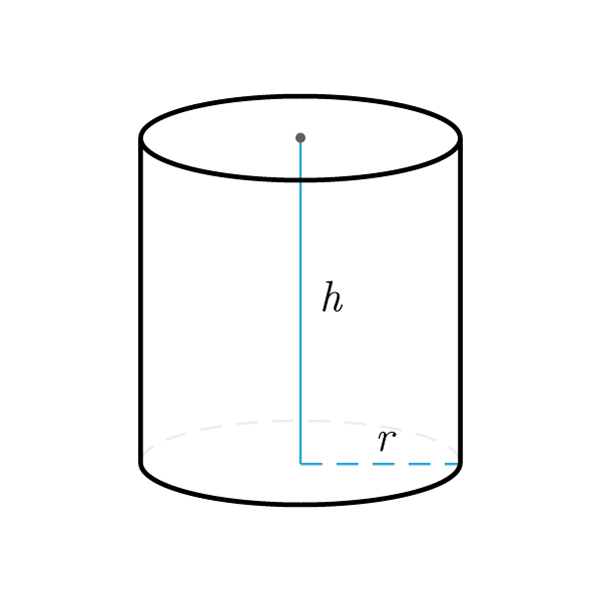|
|
|
$$V = \pi r^2 \times h$$
Volume
$$r = \sqrt{\frac{V}{\pi h}}$$
Radius
$$h = \frac{V}{\pi {r}^2}$$
Radius
$$V = A_{base} \times h$$
Volume
$$A_{base} = \frac{V}{h}$$
Base area
$$h = \frac{V}{A_{base}}$$
Height
$$S_{lat} = 2 \pi r \times h$$
Lateral surface
$$r = \frac{V}{2 \pi h}$$
Radius
$$h = \frac{V}{2 \pi r}$$
Height
$$A_{base} =\pi {r}^2$$
Base area (Area of the circle)
$$r = \sqrt{\frac{A_{base}}{\pi}}$$
Radius
$$S_{tot} = 2 \times A_{base} + S_{lat}$$
Total surface
$$S_{lat} = S_{tot} - 2 \times A_{base}$$
Lateral surface
$$A_{base} = \frac{S_{tot} - S_{lat}}{2}$$
Base area
Equilateral Cylinder
$$2r = h$$
Diameter
Definition
The cylinder is a solid obtained by the complete rotation of a rectangle around one of its sides.
Properties
- In the rectangle that generates the cylinder, the side around which the rotation occurs is the height of the cylinder, while the other side is the radius.
- The height of the cylinder is generally represented by a segment that joins the centers of the two bases, more generally the height of the cylinder is any perpendicular segment that joins the two bases.
Other definitions
- An equilateral cylinder is a cylinder in which the base diameter and height are congruent.

Cylinder Formulas
| Data | Formula |
|---|---|
| Volume | V = π r × h |
| Radius | r = √( V / (π × h) ) |
| Height | h = V / (π × r2) |
| Volume | V = Abase × h |
| Base area | Abase = V / h |
| Height | h = V / Abase |
| Lateral surface | Slat = 2 π r × h |
| Radius | r = V / (2 π h) |
| Height | h = V / (2 π r) |
| Base area | Abase = π r2 |
| Radius | r = √( Abase / π ) |
| Total surface | Stot = 2 × Abase + Slat |
| Lateral surface | Slat = Stot - 2 × Abase |
| Base area | Abase = (Stot - Slat) / 2 |
Equilateral Cylinder Formulas
| Data | Formula |
|---|---|
| Diameter | 2r = h |